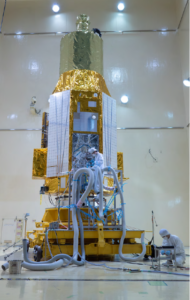Japan Launches X-Ray Telescope and Lunar Lander
Weather finally cooperated and Japan’s space agency was able to launch its new x-ray telescope, XRISM, and lunar lander, SLIM. A lot is riding on both missions. The telescope is a replacement for one that broke apart in orbit several years ago and SLIM is the third Japanese attempt to land on the Moon in the past 10 months.
The launch by Mitsubishi Heavy Industries (MHI) was delayed from August 27 EDT (August 28 in Japan) due to bad weather, but liftoff of the H-IIA rocket from Tanegashima tonight at 7:42 pm EDT (8:42 am September 7 Japan Standard Time) was perfect.
— MHI Launch Services (@MHI_LS) September 7, 2023
The X-Ray Imaging and Spectroscopy Mission, XRISM (pronounced Chrism), is a cooperative program among the Japan Aerospace Exploration Agency (JAXA), NASA and ESA.
In 2016, the JAXA-NASA Astro-H, or Hitomi, telescope broke apart in orbit due to an attitude control failure. XRISM is its replacement, but on a smaller scale with only two instead of four instruments: JAXA’s Xtend soft X-ray imager and NASA’s Resolve soft X-ray spectrometer that pairs an X-Ray Mirror Assembly with a microcalorimeter. ESA provided a star tracker and other systems.

X-ray astronomers have their fingers crossed XRISM will work. They want to avoid a potential gap in X-ray observations between the aging Chandra (NASA) and XMM Newton (ESA) telescopes launched in the late 1990s and ESA’s ATHENA planned for the 2030s. X-rays don’t penetrate Earth’s atmosphere so space-based telescopes are the only way to study the universe in those wavelengths.
Jonathan McDowell, an x-ray astrophysicist at the Center for Astrophysics|Harvard & Smithsonian who works with the Chandra space telescope, tells SpacePolicyOnline.com that “XRISM’s images won’t be as sharp as Chandra and XMM-Newton, but it has excellent spectral (color) resolution – like a hyperspectral imager in the optical.”
XRISM is “pioneering the microcalorimeter technology” that will be used on future X-ray observatories, McDowell adds, measuring “the velocity, temperature and composition of hot gas in astronomical objects such as clusters of galaxies.”
In an August 27 thread on X, McDowell (@planet4589), also known for his Jonathan’s Space Report website, explained the long, complicated history of attempts to launch a microcalorimeter.
There have been many attempts to do orbital astronomy with this device, and so far all have them have failed due to no fault of the device itself. It is the cursed detector technology. Here is the history:
Try 1: put it on the Advanced X-ray Astrophysics Facility (early 1990s). Result: Budget cuts, project split into AXAF-I (now called Chandra) and less ambitious AXAF-S
Try 2: put it on the AXAF-S spacecraft mission. Result: More budget cuts, AXAF-S cancelled.
Try 3: collaborate with Japan, put it on their ASTRO-E mission (launch: 2000) Result: Rocket nozzle falls off at launch, rocket (and ASTRO-E) falls in ocean.
Try 4: Rebuild almost identical copy of ASTRO-E, called ASTRO-E-II. Result: Not identical enough. ASTRO-E-II launched and renamed SUZAKU. But design change caused thermal short and boiling off of all helium cyrogen during initial on-orbit testing before any observing done.
ASTRO-E-II was launched in 2005, by the way. 11 years later, in 2016, Try 5: ASTRO-H, named HITOMI on orbit. Finally, ~two fantastic calorimeter spectra of astronomical objects from orbit but then HITOMI spun out of control and flew apart into pieces.
As well as the main body of the spacecraft, 13 pieces of orbital debris were cataloged. Everything has reentered now except for the main body and a large debris object we think is the optical bench section.
Try 6 : If at first you don’t succeed…. launch of XRISM is scheduled for 0026 UTC tonight! Cross your fingers….
The launch didn’t go that day, but did today and so far so good for XRISM.
The Smart Lander for Investigating Moon, SLIM, is the other payload launched today. JAXA’s primary objective is to make a survivable landing on the Moon with pinpoint accuracy of 100 meters. Conducting operations during one lunar day would be a bonus.

JAXA’s first attempt to land on the Moon, Outstanding MOon exploration TEchnologies demonstrated by NAno Semi-Hard Impactor — OMOTENASHI — was one of the 10 cubesats that rode along on NASA’s Artemis I test flight last November. The 12.6 kilogram OMOTENASHI failed when stable communications could not be established. (Most of those cubesats failed.) It also carried a 700 gram baseball-like transformer rover developed by JAXA and the toy company Takara Tomy.
In April, a Japanese commercial company, ispace, attempted the first commercial lunar landing with HAKUTO-R M1. A software error doomed the mission just before touchdown. ispace is undaunted and work on M2 and M3 is already underway for launch in 2024 and 2025.
Hopefully JAXA will be there before that. SLIM will take 3-4 months to reach lunar orbit and spend about a month in orbit before making its descent to the surface in early 2024. SLIM carries two tiny Lunar Excursion Vehicles, LEVs. LEV-1 is a hopper. LEV-2 is a transformer rover similar to OMOTENASHI.
User Comments
SpacePolicyOnline.com has the right (but not the obligation) to monitor the comments and to remove any materials it deems inappropriate. We do not post comments that include links to other websites since we have no control over that content nor can we verify the security of such links.